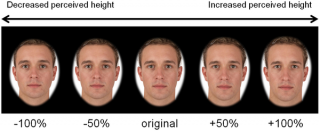Leadership
“Don’t Judge a Book by Its Cover”: Faces, Height, & Leaders
We definitely judge politicians by their covers.
Posted January 5, 2014
I recently finished grading a big pile of end-of-semester research papers. The first several aren’t too bad to grade, but as I get tired it becomes harder to read the 17th or 32nd paper with the same detailed eye and enthusiasm with which I read the first few. (Poor me…can you hear the world’s smallest violin playing the world’s saddest song in the background?).
I find if I’m not careful I start taking shortcuts in grading like being influenced by the student’s previous class performance. It’s easy to assume an A student making an unclear statement still “gets it,” while a similar statement by a C student indicates he or she does not. In other words, I have to be careful not to do what parents constantly warn their little ones about: “don’t judge a book by its cover.”
JUDGING POLITICIANS BY THEIR “COVERS”
Most political issues are very complicated and, therefore, are difficult and time consuming to stay informed about. And people are busy with work, school, family, and assorted other “distractions” from political matters.
So we often use shortcuts to help us make political decisions, and the evidence suggests they do help us make better choices. Some of the most popular shortcuts regarding voting for a candidate are party affiliation, political ideology, endorsements, viability in public opinion polls, and physical appearance.
Assessing a candidate on her or his appearance is the ultimate of “judging a book by its cover.” But there’s a lot of evidence we use this shortcut. For instance, researchers have found that pictures of candidates predicted people’s voting decisions in not only the US but also Australia, Canada, Iceland, Italy, Japan, and the UK. The argument is that people pick up cues of competence and trustworthiness from candidate photos.
HEIGHT IS A SHORTCUT, TOO
I’ve also noted in other posts the effect of height on voter preferences (e.g., “It’s Weird, Candidate Height Matters in Elections”). Some of my research suggests we prefer leaders with taller stature because the stature of our allies may be a clue to our ability to acquire and protect resources. From an evolutionary perspective, when our ancestors had a big, strong friend who would help them obtain the essentials of survival and reproduction, e.g., food, shelter, and territory, they had a relative advantage in terms of living longer and producing more children.
WAIT! FACES ARE A SHORTCUT TO WHAT ELSE?
One of the questions for researchers studying faces is what information do faces convey that help us make leadership choices? A number of studies show leaders’ faces convey characteristics like competence and trustworthiness.
But a group of UK and South African researchers speculated that faces also signal information about a person’s height. In one study, the researchers measured the shape of a large number of female and male faces in terms of facial structure, after which they had subjects rate the faces for several characteristics including estimated height of the person the face belonged to.
What did they find? As you probably expect by now, they found that facial structure, in particular elongation, was related to the height they estimated for the people shown to them. In other words, some facial structures seem to signal a person is taller and some signal a person is shorter. And, by the way, the subjects’ predictions of height were fairly accurate estimates of the actual height of the people the faces belonged to. So the facial signal for height is reasonably useful.
But wait, there’s more. They also had the subjects rate the faces in terms of leadership ability (i.e., “how good of a leader do you think this person is?”). And they found that the height perceived from the faces had a “strong and significant” effect on how the subjects rated leadership ability. Altogether, this suggests we use height as a shortcut for evaluating leaders, and we use faces as a shortcut to judging height.
In a second study, the researchers selected and averaged faces from the first study to create a number of composite faces, each of which they transformed into a series of 20 pictures ranging in facial structure from very short to very tall height. Each facial composite varied in perceived height shape only, with no differences in other facial characteristics such as color or texture. Then they had subjects select the face from each composite that looks “most like the person you would perceive to be a good leader.”

Figure 1: doi:10.1371/journal.pone.0080957.g002
They found that subjects maximized perceived leadership ability by selecting faces with greater perceived height in all the composites. Further, they found that subjects did this by selecting faces with 45% increased height transformation on average. Similar to the first study, then, this one shows that we take information from faces to help us judge people’s height and their leadership ability.
WE’RE DEFINITELY “JUDGING BY COVERS”
It’s very clear that in the complicated world of politics we do a lot of cover judging. Candidate faces matter. Candidate height matters. And this research suggests that candidate faces and heights get entangled in very interesting ways that also matter.
As one of my colleagues at the Association for Politics and the Life Sciences commented regarding this research, What does this mean for democracy? Well, to wrap up my story about grading papers, one way I avoid taking a shortcut to grading is to have students turn in papers with their student ID numbers on them and not their names. This way I take the shortcut off and judge the student’s “book” and not the cover. Hmmm….
- - - - - - -
For more information:
Re DE, Hunter DW, Coetzee V, Tiddeman BP, Xiao D, et al. (2013) Looking Like a Leader–Facial Shape Predicts Perceived Height and Leadership Ability. PLoS ONE 8(12): e80957. doi:10.1371/journal.pone.0080957
In addition to writing the "Caveman Politics" blog for Psychology Today, Gregg is the Executive Director of the Association for Politics and the Life Sciences and an Associate Professor of Political Science at Texas Tech University.
If you enjoyed this post, please share it by email or on Facebook or Twitter. Follow Gregg on Twitter @GreggRMurray or “Like” him on Facebook to see notes on other interesting research. You can find more information on Gregg at GreggRMurray.com.




